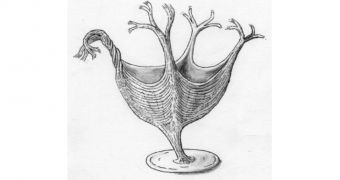Animals that roamed the Earth hundreds of millions of years ago probably did not care all that much about sporting the perfect six-pack, but they did have muscles, and relied on them not so much to impress their crushes but to get around.
According to scientists with the University of Cambridge in the UK, the world's first muscles developed about 560 million years ago, and were part and parcel of the anatomy of a rather bizarre creature.
This creature, whose appearance is reconstructed in the image next to this article, inhabited aquatic environments, and belonged to the same group of animals as modern corals, jellyfish, and sea anemones do.
In a paper in the journal Proceedings of the Royal Society B, University of Cambridge scientists and fellow researchers explain that the fossilized remains of one such an ancient aquatic animal were not too long ago unearthed in Newfoundland, Canada.
While studying these remains, specialists pinned down anatomical particularities that they claim to be the earliest impressions of muscular tissue to have until now been documented by science, the Alpha Galileo Foundation informs.
What they mean is that this creature whose fossilized remains were discovered in Canada flexed the world's first muscles. Whether or not these muscles were impressive enough to help it make it on the cover of an Ediacaran Period magazine is yet to be determined.
Writing in the journal Proceedings of the Royal Society B, the scientists behind this research project detail that this newly discovered cnidarian species said to constitute the earliest evidence of animals with muscles is now known as Haootia quadriformis.
As noticeable in the image accompanying this article, animals belonging to this species had a fairly peculiar anatomy. In a nutshell, their body had a four-fold symmetrical arrangement. It is believed that the bundles that gave it his shape comprised muscular tissue.
Specialists say that, all things considered, these ancient creatures developed muscles in order to be able to pick and choose between various places that they wanted to visit and move in one direction or another to their heart's desire. Simply put, they wanted to be in control of their daily schedule.
“The evolution of muscular animals, in possession of muscle tissues that enabled them to precisely control their movements, paved the way for the exploration of a vast range of feeding strategies, environments, and ecological niches, allowing animals to become the dominant force in global ecosystems,” explains researcher Alex Liu with the University of Cambridge.

 14 DAY TRIAL //
14 DAY TRIAL //